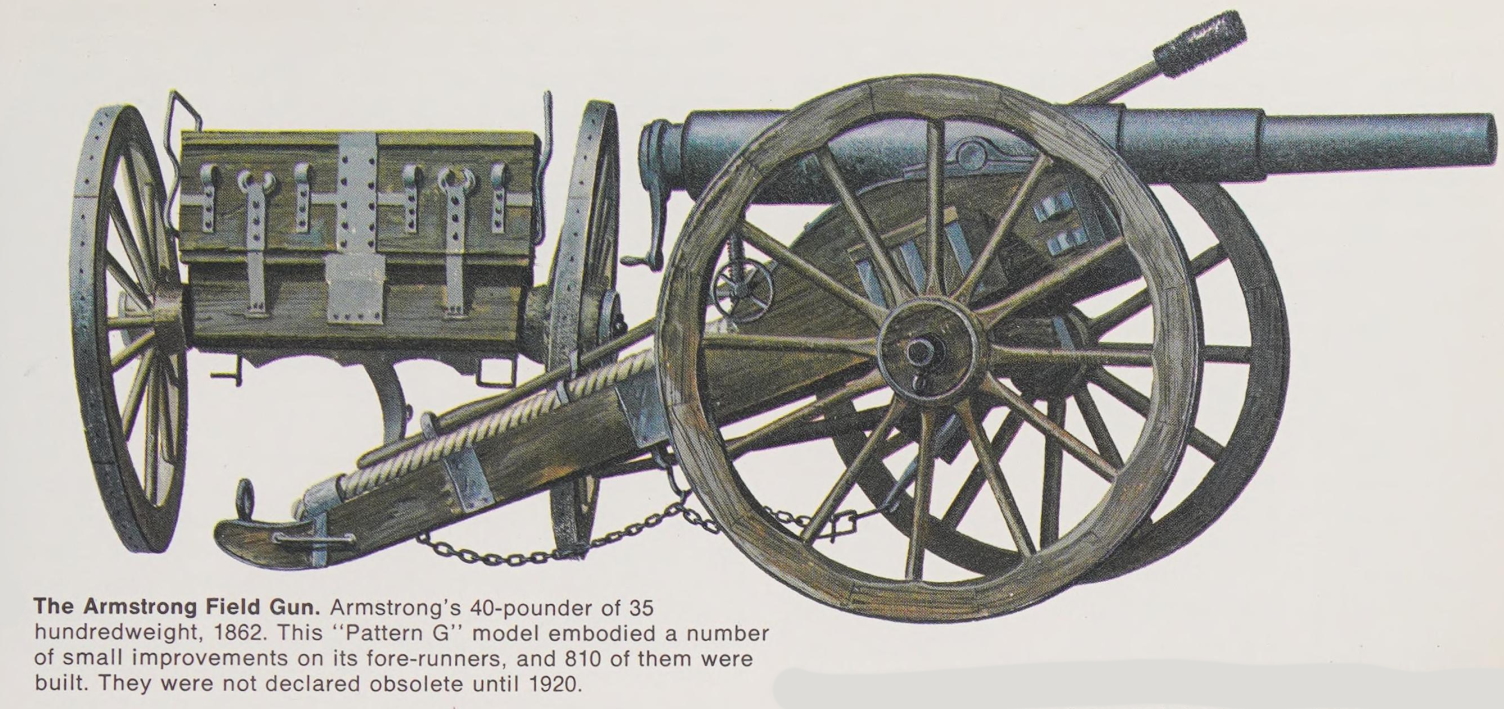
The official approval of the Armstrong 40-pounder RBL gun included this drawing which gave details of the gun sights and breech vent-piece.
Originally trained as a lawyer, Sir William George Armstrong (1810-1900) turned his talents to engineering, inventing hydraulic engines and cranes. In 1854 he patented a wrought iron rifled cannon that incorporated a number of graduated reinforcing bands, giving it a distinctive stepped profile. Armstrong also developed a unique “shunt” type of rifling, with each groove cut to two depths to accommodate the system’s special studded projectiles. The deeper half of the groove provided extra space to ease loading, whereas, upon firing, the studs shifted to the shallow side to provide the close fit within the bore necessary for accuracy. The powder charge was contained in a separate bag. The breech mechanism consisted of a separate wrought iron vent piece that was inserted into a slot in the top of the piece and locked into position by way of a large screw in the rear of the gun. A copper ring in the face of the vent piece expanded on firing to seal the breech and prevent the escape of gasses and subsequent loss of energy.
In July 1855, Armstrong submitted a 3-pounder breechloader for tests to the master general of the ordnance, and after a series of trials against other designs a special committee approved it for the British service on 16 November 1858. Upon the acceptance of his design, Armstrong relinquished all patent rights to the Crown and was subsequently appointed superintendent of the Royal Gun Factory at Woolwich in November 1859. By March 1861, Armstrong had overseen the manufacture of 941 of his guns for the British army, as well as guns for the Royal Navy. The most popular Armstrong for field use, the 3-inch 12-pounder, had a range of some 2,200 yards. One of the more long-lived Armstrongs, the Model 1862 “Pattern G” 40-pounder, remained in service until 1920. Production of the Pattern G totaled some 810 guns. The 70-pounder 6.4-inch breechloading Armstrong fired a 79.8- pound projectile loaded with a 5.4-pound bursting charge 2,183 yards. Examples of large 8.5-inch (150-pounder) 120-inch-long muzzle loading Armstrongs weighed up to about 15,790 pounds and required a 20-pound charge.
Armstrong Model 1862 “Pattern G” 40-pounder
A number of different carriages for guns employed for Land Service were available. A wooden siege carriage with wheels and attached limbers, enabled the guns to be drawn by teams of heavy horses.
For guns mounted in fortifications they could be mounted on two different types of carriage. The first was an iron traversing carriage, enabling the gun to be traversed right and left, with recoil being absorbed with a carriage being mounted on a slide. Others were mounted on high “siege travelling carriages” for use as semi-mobile guns in forts, firing over parapets.
Many were re-issued to Volunteer Artillery Batteries of Position from 1889, with 40 Pounders among 226 guns issued to the Volunteer Artillery during 1888 and 1889. The 1893 the War Office Mobilisation Scheme shows the allocation of thirty Artillery Volunteer position batteries equipped with 40 Pounder guns which would be concentrated in Surrey and Essex in the event of mobilisation. They remained in use in this role until 1902 when they were gradually replaced by 4.7-inch Quick Firing (QF) guns. A number were used for some years afterwards as saluting guns.
Production history
Designer W.G. Armstrong Co.
Manufacturer W.G. Armstrong Co.
Royal Gun Factory
Produced 1859 – 1863
No. built 1013
Variants 32cwt, 35cwt
Specifications
Mass 32 cwt (3,584 pounds (1,626 kg)), later 35 cwt (3,920 pounds (1,780 kg)) gun & breech
Barrel length 106.3 inches (2.700 m) bore & chamber
Shell 40 pounds 2 ounces (18.20 kg)
Calibre 4.75-inch (120.6 mm)
Breech Armstrong screw with vertical sliding vent-piece (block)
Muzzle velocity 1,180 feet per second (360 m/s)